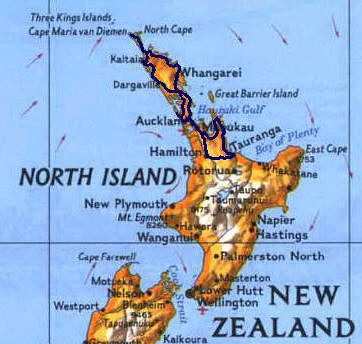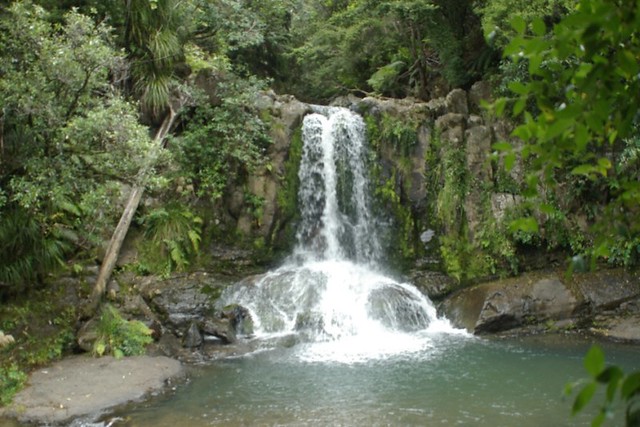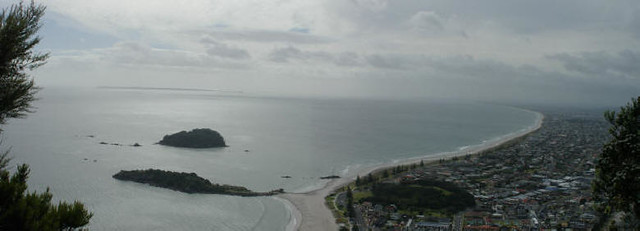12/19/04 - 01/14/05
by KT
We seemed to cover a lot of "territory" in this time period ... as usual we captured most of it via our cameras. Since we can never seem to come up with the words to accurately describe the beauty, it just seemed to make sense to do another "photo journal" (not to mention easier). We hope we don't overwhelm you with the quantity of photos in this journal, but we think they are all worth viewing (so grab a cup of 'jo and enjoy!).
The Holidays
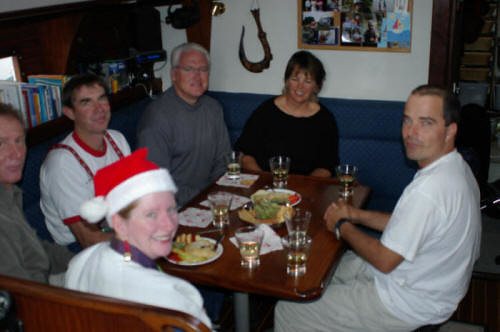
After our eight-day tour of the Northland, it was back to Billabong and our 'normal' routines. Lots of email, landline phone calls to the States and general about-the-town activities. I was really hoping for an intimate and somewhat traditional Christmas, so Chris and I decided to invite some of our friends over for a huge Christmas feast. It seems that I started planning the meal weeks ahead of time ... with only two burners and a very tiny oven I wasn't sure how we would pull off the dinner I was dreaming of ... but we more then managed (especially with the help of the grocery store butcher who specially cut the Crown Roast short so that it would fit in our itty bitty oven). Our guests for the evening were John & M.J. (Island Sonata), Duncan & Robin (Whisper), and Fred (Mary C). Seven was a lot to crowd around our little table, but it just added to the ambiance. Dinner turned out fantastic with an Apricot Ginger & Cranberry Brie Pastry appetizer, followed by a 5 course dinner consisting of Crown Roast of Pork with Cranberry-Apple stuffing, fresh Mashed Potatoes and Gravy, Christmas Salad, Homemade dinner rolls, and an awesome Fruit Salad (brought by Island Sonata). Not thinking we could eat another bite, we somehow managed to still get down Oreo Cookie Cheesecake & Pumpkin Swirl Cheesecake ... whoever would of known such a feast could come from such a small galley!
A few days after Christmas we enjoyed a visit from Ralph & Donna (Ocean Girl). They came down from Opua and spent the night with us aboard Billabong. We enjoyed a homemade meat pie (thanks to Donna) and left-over cheesecake.
The next thing we knew the New Year was upon us. Michael & Mary (de la Mer) were visiting and joined us and Island Sonata for a fantastic dinner out at Killer Prawn (doesn't it seem the holiday's are all about eating?!?!). Killer Prawn hosted a live Spanish-style band ... so along with great food & wine we enjoyed some lively dancing! Somehow we managed to stay awake to midnight (difficult considering we're on cruisers hours, therefore typically hitting the hay around 9/10pm).
Mom's 10 day visit
As my mom (Denise) was arriving at 5:00 AM and the Auckland airport was a good 2-1/2 hours away, we opted to head down to Auckland on the 2nd and stay in a Holiday Park near the airport. Five AM arrived quickly and our first visitor (of many) had finally arrived! I couldn't believe that a year had already gone by. After a chatty drive back home to Whangarei, Chris & I enjoyed a second Christmas ... my Mom had brought lots and lots of goodies from the states, including Bisquick quick packs, Skippy Peanut Butter, a new zoom camera lens and camera backpack, and a replacement camera for Chris (seeing as I toasted his last one when I toppled over the wall in Tonga). She also brought lots and lots of pictures which we thoroughly enjoyed going through. Between our early wake-up call and jet lag we decided to have a lazy day around Whangarei.
Mom's Visit Day 2 (Jan 4th)
Since it wasn't raining we figured it was a great day for a walk ... the Whangarei Falls offered great views, a stroll through a small Kauri forest, and a terrific waterfall.
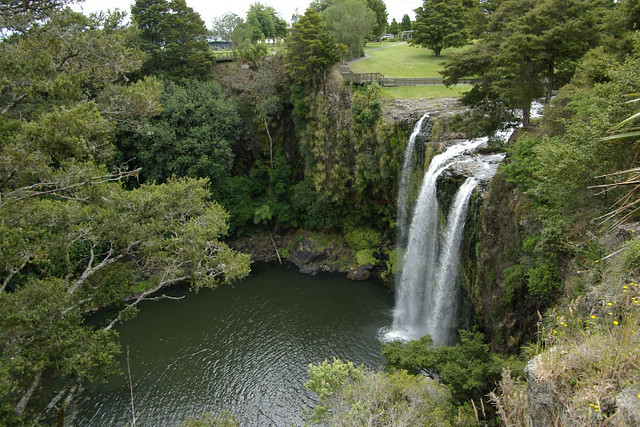
Mom's Visit Day 3 (Jan 5th)
Next up was a visit to Heritage Park located just around the bend from the Harbor. Heritage Park offered a variety of attractions, including an old historic New Zealander's house, Old Engines (maintained by a local Engine's club), a Bird information center and hospital, and a 'famous' talking Tui ... who sounded JUST like a deep-voiced man. He entertained us with "Merry Christmas", "Wanna going swimming", and "Hello".
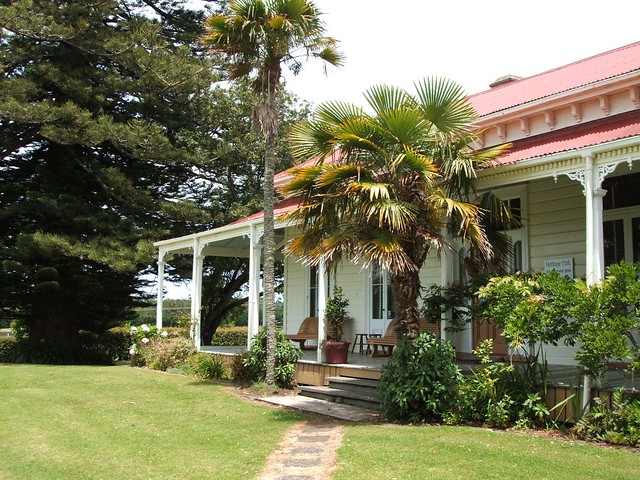
Mom's Visit Day 4 (Jan 6th)
Unfortunately the weather was still not cooperating, as we awoke to another cloudy, dreary day. But we didn't let the lingering clouds damper our spirits as we headed south towards Warkworth for a visit to Sheepworld. We opted for the scenic coastal drive out to Manawhai Heads, enjoying the beautiful views and sandy beaches.
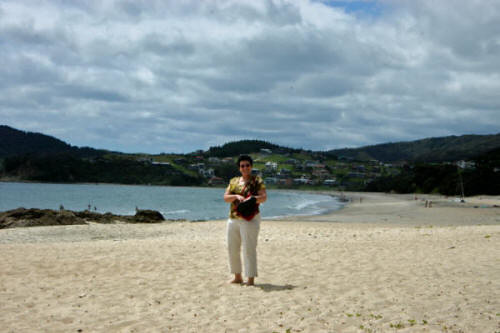
Sheepworld was the first really touristy thing that Chris and I did in NZ ... and in my opinion one of the most fun! I had talked Chris into going under the ruse that my mom would like it, but in all honesty I was itching to go! In the end I think Chris enjoyed hand feeding the farm animals and the sheep herding show as much as my mom and I!
As the sheep-herding dog show started I selfishly commented to Chris, "Bummer that all these kids are here, they're the ones who will get to do all the [interactive] stuff!". However, kudos to the commentator as he asked for "big kid" volunteers as well, and Mom & Chris were sure to give me the nudge to get out there ... I got to try my hand at sheep sorting and enjoyed bottle feeding a baby pig. After my (quite pathetic) attempt at sheep sorting I have a whole new respect for farmers.
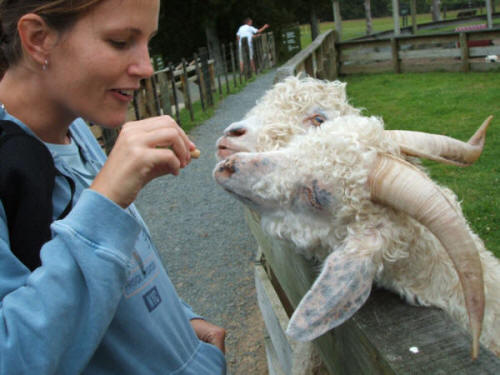
We finished the day off with a drive up to a lookout point over Whangarei.
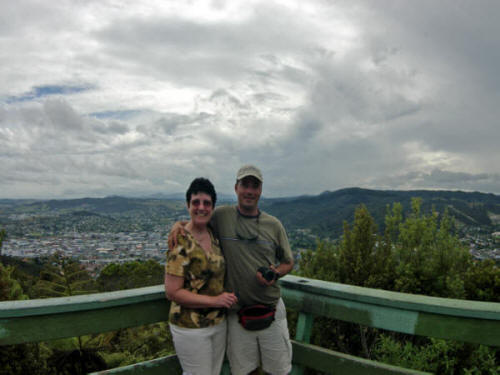
Mom's Visit Day 5 (Jan 7th)
Since it was raining, it was a good day for relaxing around the boat and catching up on our books. We also prepared for our upcoming South Island / Glacier visit.
Mom's Visit Day 6 (Jan 8th)
Off to the Auckland airport for our flight to Christchurch ...
Just as we arrive at the airport our nostrils were filled with the strong odor of anti-freeze! One of Billavan's hoses had cracked wide up and was now spewing anti-freeze all over the airport parking lot. With a flight to catch Chris took a cursory glance in order to figure out what supplies to buy before our return trip from the South Island. As it turns out this was one of many "lucky" breakdowns ... lucky in that the van decided to breakdown just as we hit our destination (you'll read about the other breakdowns in future journal pieces).
It was a rainy/overcast day, so we didn't get to see much on the flight between islands. In Christchurch we rented a car and headed West across SH 73, through Arthur's Pass and on into Glacier country. At one of our lookout stops, we were introduced to the Kea, a very social mountain parrot who is know for eating plastic and rubber off of cars and camping gear!!!
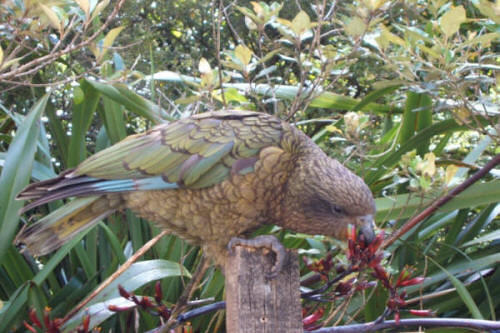
It was raining off and on, but we still managed to enjoy a few great views. We were amazed at the difference in scenery between the "wet" side and the "dry" side of the Alps ... it was as though we were in two different countries! In addition, the long drive included flat farm lands, the mountainous Southern Alps, and ocean-side highways ... making the drive continuously interesting.
Mom's Visit Day 6 (Jan 9th)
Although it had been pouring down rain when we arrived, we woke to stunning blue skies. We were very excited as today's adventure was all about hiking part of the Franz Josef Glacier. We were booked for one of the morning 1/2 day glacier hikes, so it was a get-up-and-go morning as we headed off for the tour. It was a bit of a shock when we arrived and were shown a picture of the ever growing, and increasingly steeping glacier. Both Chris and I started getting nervous, not only for ourselves (after looking at the picture I had serious doubts as to whether I was up to the challenge), but also for my Mom (hiking glaciers isn't a very common activity in Yuma, Arizona). She however was overly gung-ho and bursting with energy (we learned later that she really didn't get a good look at the picture!!!). We also learned that the Franz Josef & Fox Glaciers are fast moving glaciers, with flow reates up to 3m PER DAY!
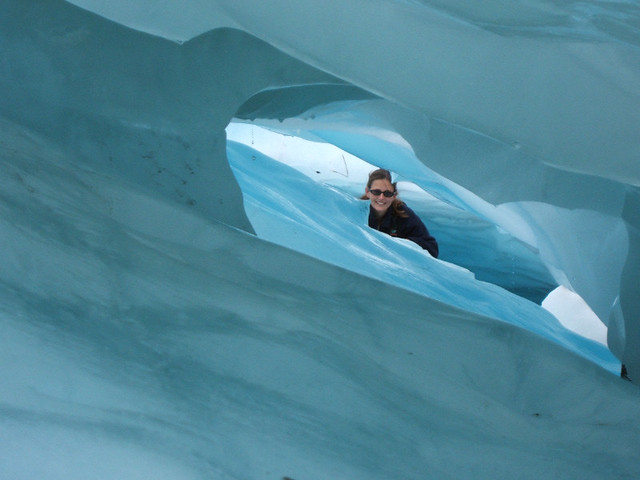
We were outfitted with raincoats, boots, and ice-Talonz (basically a set of spikes that cover the entire sole of the boot and are hinged in two places, allowing unimpeded walking and "superior" glacier grip), then shuffled onto a bus for a short trip out to the glacier. We knew that our group would be splitting into three smaller groups based on desired hiking speed (slower, faster, and somewhere in between). The faster you hike, the higher you get, and therefore the more "cool" stuff you get to see (such as ice crevices, ice caves, tunnels, etc). Prior to getting on the bus Mom had told us that we should go with one of the faster groups, but that she wanted to take here time with the more leisurely paced group. Chris and I were torn, we couldn't decide if we should really leave Mom or not (it sort of felt as though we would be just ditching her, what kind of daughter would that make me???). It was a bit funny when Chris and I (who were at the back of the bus, while my Mom was at the front) were discussing what we should do, saying things like "Do you think she'll be okay?" ... "Should we really leave her alone?" ... "You think it is going to be too hard?" ... "Maybe she'll need/want company", and a man sitting next to me said, "Oh, do you have a child also?". "No," I replied, "we have a Mom!". "Ahh, just about the same thing!" he said with laughter! In the end, with Mom's blessing (and urging), Chris and I joined the fast group, leaving Mom to handle the big-bad block of ice on her own!!!
One of the most amazing things about the glacier is the approach. The hike starts with a forty-minute tramp through a pretty dense rain forest that leads you to an open, dry, rocky terrain. Another forty minutes (of mostly flat walking) or so and you are looking up and a humongous block of ice (the glacier). At the bottom of the glacier we were instructed on how to hook on our ice-Talonz and how to walk & climb to make them as effective as possible, and to avoid catching them on your pant legs (which would then trip you up).
As I looked up the side of the glacier my stomach flipped with nervousness ... "I am not this fit." I was thinking, "Why the hell did I come in the fast group?". But nobody in our group really looked like serious fitness buffs, so I tried to reassure myself that all would be well. And of course it was. The guides carve steep ice steps into the side of the mountain, and the going is actually quite slow. It felt even steeper than it looked and I did have a few moments where I visualized myself slipping backwards off one of the steps into oblivion. Even worse, I had a few moments of serious guilt that I had left Mom behind, as I visualized calling my sister to tell her that I had caused Mom's demise! Perhaps my visualization skills can be too good sometimes!
We made our way slowly up the glaciers, using hand ropes and carved steps to ascend. I kept looking down below hoping to see Mom's black head in one of the tiny people-specs below. A few times I thought I saw her, but I'm pretty sure it was just my imagination trying to put me at ease. Once past the super-steep part, the going was much easier, and I could finally relax and enjoy the views. We traveled through a few crevices and got a chance to look through a few tiny ice caves, but a 1/2-day hike didn't allow for much time, and before we knew it, we were on our way down again. For someone a bit afraid of heights, the climb down was just as scary as going up. There was nothing to stop you should you take a wrong step, slip, or trip. As if to reinforce this point, just as we were nearing the bottom, a woman in a group in front of us caught her ice-Talonz on her pant leg, tripping her up. She fell about 25 feet into a rocky crevice. We didn't actually witness the fall, but we did hike past her ... and it was not a pretty sight. She was fine (in that she didn't break her neck), but she did have a pretty good cut on her head, and had dislocated her shoulder. I was quite happy and relieved when we made it down to the bottom, and even more so, when we found Mom sitting there, safe, healthy, and happy!!!
To top of this fantastic day, it didn't start raining until we had finished our hike!!! This was such a terrific adventure, that we took almost 200 pictures! I've tried to pick the better ones, but there are still so many that I felt it would be a little overwhelming to have them all in the journal ... click on the photo below to link over the photo album of Franz Josef Glacier!
Side note: a few days after Mom's departure from NZ, Chris found an article in the local newspaper with the subtitle: "Climbers are now screened because the steep trek is more dangerous"! The article went on to state that the glacier was rapidly expanding outwards, becoming steeper at its front. The manager of Franz Josef Glacier Guides was quoted saying, "It's a safety issue. The climb is tougher now and you have to remember it's not sturdy rock, it's slippery ice. You fall, you're gone." Yikes!!! Glad we read that AFTER doing the hike :) Now all my worrying doesn't seem so cowardly eh?
I had made a [minor] booking error and booked us 20 minutes down the road at a holiday park in Fox Glacier rather than Franz Josef ... which turned out to be quite lucky after all, as the scenery between the two glaciers was fantastic, and it gave us an opportunity to explore both Gillespies Beach and take a look at Fox Glacier.
After our tiring morning we didn't hike to the base of Fox Glacier, but did get the opportunity to see it via a couple of different lookout points.
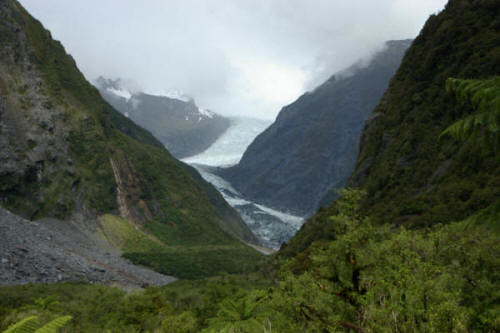
Rain forest walk to viewpoint of Fox Glacier Lots of tree ferns lined the path Waterfalls could be seen through the dense forest Fox Glacier Next we drove to the car park near the base of Fox, which is surrounded by towering, dramatic cliffs horizontal rule
Since it was still too early for dinner, we decided to drive out to Gillespies Beach. By now the sun had again broken through and we had some fantastic views of the Glaciers and Southern Alps Range. We were a bit hesitant to drive all the way to the beach when we encountered a huge "EXTREME DANGER" sign (regarding road conditions), but what the heck, we were in a rental after all! Turns out the road is not that bad. Gillespies Beach was terrific, you could stand and do a 360, seeing beach, rain forest, mountain ranges, and the glaciers ... all from one spot! We didn't spend long on the actually beach as the sand-flies were horrendous. We also had some fun with the farm animals along the way ... we had stopped the car to take a picture, when I noticed that a couple of the cows were looking up at me, so (naturally) I mooed at them, "Mooo Moooo Mooo" ... I kid you not, EVERY cow in the paddock looked up at me ... so of course I kept on Mooeing "Mooo Mooo Mooooooo" ... next thing I knew they were all running, yes RUNNING, towards me! Luckily there was a fence, so I had nothing to worry about (although I later learned that cows are able to knock over and/or jump the fences when properly provoked). It was one of the funniest sites ever (at least funny to a non-farm girl from California).
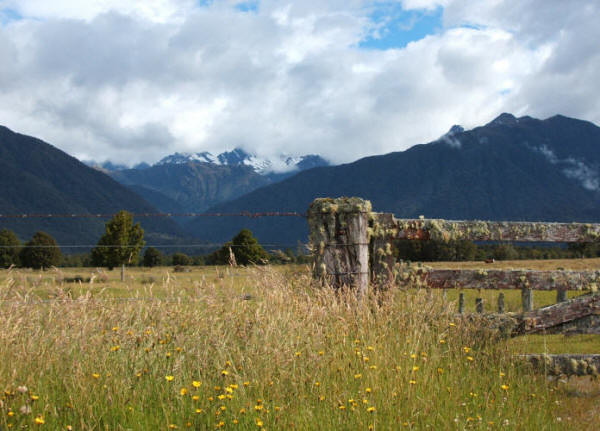
Finally, it was back to the holiday park, hot showers, and a nice dinner out (to reward ourselves for completing the Glacier Hike).
Mom's Visit Day 7 (Jan 10th)
Chris was so motivated by all the great scenery, that he woke early and went out to try and get some good shots (photographs) with the soft morning light. Later, the sky was so clear and blue that we all went out to take even more photographs, hoping to capture the majestic sights that surrounded us. We probably went a little overboard on route to Arthur's Pass, continuously jumping out of the car to snap off a few shots ... but it was wonderfully beautiful and we desperately wanted to capture "the moment" on film! Click on the photo below to view the photo gallery of our journey from Glaciers to Arthur's pass (in my non-professional opinion there are some great photos in this album that you just won't want to miss ... so be sure to click and check them out!!!!).
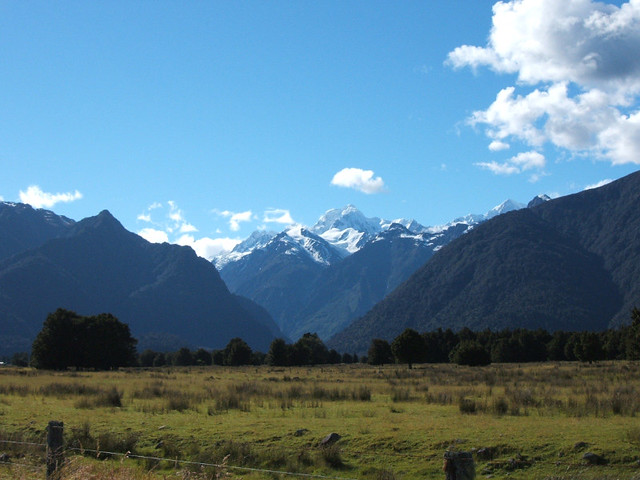
Arthur's Pass was a quaint (i.e. small) little town with fields and fields of purple flowers (whose name escapes me). By now it had clouded over and was raining on & off, so after a brief walk around town (doesn't take to long when there is only one street with all of four buildings), we stopped in at a cafe for dinner. We had a most excellent pizza, with smoked chicken, cranberry sauce, and brie (yes, I was hesitant at first too!).
Mom's Visit Day 8 (Jan 11th)
It was time to head back to the North Island. We made our way from Arthur's Pass to Christchurch. Since our flight wasn't until later in the afternoon, we were able to stop in at the Antarctic Centre. This is a terrific center with interactive displays, videos, and a Hägglund Ride (an all-terrain vehicle used in the Antarctic). There are displays on Antarctic's wildlife, and in-depth information about Scott Base. We spent a couple of hours exploring the centre, and easily could've spent a bit more. During lunch (at the Center's cafe) Chris ran across the street to get a glimpse of the US Antarctic Center, spotting one of the planes departing for Antarctica. The Centre was SO interesting that it made both Chris and I want to visit someday (in the Summer of course). We were very surprised to find that even Lonely Planet has a guide for Antarctica!
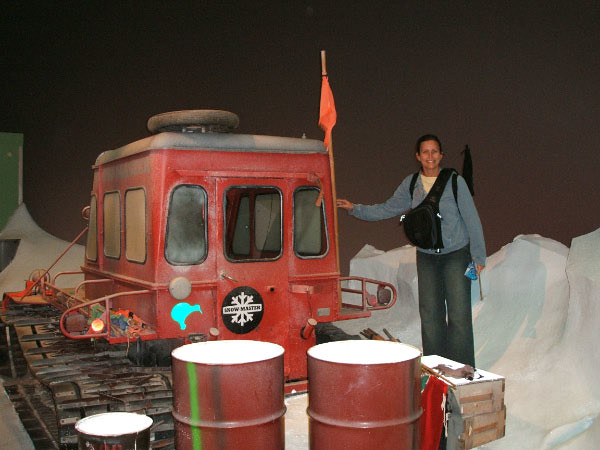
On the plane ride back we had a clear view of Egmont National Park and the massive 2518m dormant volcano, Mt Taranaki (click on photo to left). Chris had to work his handy magic on Billavan when we got back to the airport parking lot (fixing the hose that busted when we arrived). Handy as he is, it wasn't too long before we were on the road headed back to Whangarei.
Mom's Visit Day 9 (Jan 12th)
It was a nice day to relax, and we took a leisurely drive out to Whangarei Heads, overlooking a couple terrific bays, talking to cows, and visiting a beach or two.
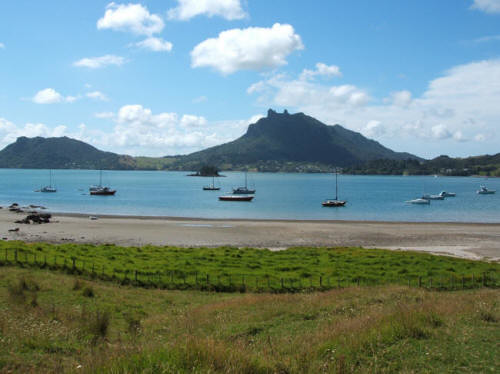
Mom's Visit Day 10 (Jan 13th)
It seemed like just yesterday we were picking Mom up at the airport, and now it was time to get ready to go back. We mostly lazed around ... taking time to visit a few shops (where Mom stocked up on last minute souvenirs) and enjoying a bit of sunshine.
Mom's Visit Day 11 (Jan 14th)
It was another drive to Auckland (by the end of our stay in NZ we would have this route down pat!). We enjoyed a bit of walking around Warkworth, where we stopped for lunch and a look at the nearby channel. We got Mom safely to the airport ... I couldn't believe that it had been a year since I'd last seen her, and would probably be another year or so before I saw her again. At least I knew the time would go quickly ... but still her visit reminded me of how much I missed home at times, and how many family members & friends I wouldn't get to see this year.
After dropping Mom off, Chris and I hooked up with Robin & Duncan for dinner in Auckland (their boat, Whisper is currently docked across the bay from Auckland). It was a terrific dinner (excellent fish) and it was fantastic to catch up with Robin & Duncan. Since we stayed out late, we opted to spend the night in a local Holiday Park before heading back to Whangarei the next morning.
Well, some 200 pictures later ... it was quite the time with Mom and a superb Holiday season!
by KT
We seemed to cover a lot of "territory" in this time period ... as usual we captured most of it via our cameras. Since we can never seem to come up with the words to accurately describe the beauty, it just seemed to make sense to do another "photo journal" (not to mention easier). We hope we don't overwhelm you with the quantity of photos in this journal, but we think they are all worth viewing (so grab a cup of 'jo and enjoy!).
The Holidays

After our eight-day tour of the Northland, it was back to Billabong and our 'normal' routines. Lots of email, landline phone calls to the States and general about-the-town activities. I was really hoping for an intimate and somewhat traditional Christmas, so Chris and I decided to invite some of our friends over for a huge Christmas feast. It seems that I started planning the meal weeks ahead of time ... with only two burners and a very tiny oven I wasn't sure how we would pull off the dinner I was dreaming of ... but we more then managed (especially with the help of the grocery store butcher who specially cut the Crown Roast short so that it would fit in our itty bitty oven). Our guests for the evening were John & M.J. (Island Sonata), Duncan & Robin (Whisper), and Fred (Mary C). Seven was a lot to crowd around our little table, but it just added to the ambiance. Dinner turned out fantastic with an Apricot Ginger & Cranberry Brie Pastry appetizer, followed by a 5 course dinner consisting of Crown Roast of Pork with Cranberry-Apple stuffing, fresh Mashed Potatoes and Gravy, Christmas Salad, Homemade dinner rolls, and an awesome Fruit Salad (brought by Island Sonata). Not thinking we could eat another bite, we somehow managed to still get down Oreo Cookie Cheesecake & Pumpkin Swirl Cheesecake ... whoever would of known such a feast could come from such a small galley!
A few days after Christmas we enjoyed a visit from Ralph & Donna (Ocean Girl). They came down from Opua and spent the night with us aboard Billabong. We enjoyed a homemade meat pie (thanks to Donna) and left-over cheesecake.
The next thing we knew the New Year was upon us. Michael & Mary (de la Mer) were visiting and joined us and Island Sonata for a fantastic dinner out at Killer Prawn (doesn't it seem the holiday's are all about eating?!?!). Killer Prawn hosted a live Spanish-style band ... so along with great food & wine we enjoyed some lively dancing! Somehow we managed to stay awake to midnight (difficult considering we're on cruisers hours, therefore typically hitting the hay around 9/10pm).
Mom's 10 day visit
As my mom (Denise) was arriving at 5:00 AM and the Auckland airport was a good 2-1/2 hours away, we opted to head down to Auckland on the 2nd and stay in a Holiday Park near the airport. Five AM arrived quickly and our first visitor (of many) had finally arrived! I couldn't believe that a year had already gone by. After a chatty drive back home to Whangarei, Chris & I enjoyed a second Christmas ... my Mom had brought lots and lots of goodies from the states, including Bisquick quick packs, Skippy Peanut Butter, a new zoom camera lens and camera backpack, and a replacement camera for Chris (seeing as I toasted his last one when I toppled over the wall in Tonga). She also brought lots and lots of pictures which we thoroughly enjoyed going through. Between our early wake-up call and jet lag we decided to have a lazy day around Whangarei.
Mom's Visit Day 2 (Jan 4th)
Since it wasn't raining we figured it was a great day for a walk ... the Whangarei Falls offered great views, a stroll through a small Kauri forest, and a terrific waterfall.

Mom's Visit Day 3 (Jan 5th)
Next up was a visit to Heritage Park located just around the bend from the Harbor. Heritage Park offered a variety of attractions, including an old historic New Zealander's house, Old Engines (maintained by a local Engine's club), a Bird information center and hospital, and a 'famous' talking Tui ... who sounded JUST like a deep-voiced man. He entertained us with "Merry Christmas", "Wanna going swimming", and "Hello".

Mom's Visit Day 4 (Jan 6th)
Unfortunately the weather was still not cooperating, as we awoke to another cloudy, dreary day. But we didn't let the lingering clouds damper our spirits as we headed south towards Warkworth for a visit to Sheepworld. We opted for the scenic coastal drive out to Manawhai Heads, enjoying the beautiful views and sandy beaches.

Sheepworld was the first really touristy thing that Chris and I did in NZ ... and in my opinion one of the most fun! I had talked Chris into going under the ruse that my mom would like it, but in all honesty I was itching to go! In the end I think Chris enjoyed hand feeding the farm animals and the sheep herding show as much as my mom and I!
As the sheep-herding dog show started I selfishly commented to Chris, "Bummer that all these kids are here, they're the ones who will get to do all the [interactive] stuff!". However, kudos to the commentator as he asked for "big kid" volunteers as well, and Mom & Chris were sure to give me the nudge to get out there ... I got to try my hand at sheep sorting and enjoyed bottle feeding a baby pig. After my (quite pathetic) attempt at sheep sorting I have a whole new respect for farmers.

We finished the day off with a drive up to a lookout point over Whangarei.

Mom's Visit Day 5 (Jan 7th)
Since it was raining, it was a good day for relaxing around the boat and catching up on our books. We also prepared for our upcoming South Island / Glacier visit.
Mom's Visit Day 6 (Jan 8th)
Off to the Auckland airport for our flight to Christchurch ...
Just as we arrive at the airport our nostrils were filled with the strong odor of anti-freeze! One of Billavan's hoses had cracked wide up and was now spewing anti-freeze all over the airport parking lot. With a flight to catch Chris took a cursory glance in order to figure out what supplies to buy before our return trip from the South Island. As it turns out this was one of many "lucky" breakdowns ... lucky in that the van decided to breakdown just as we hit our destination (you'll read about the other breakdowns in future journal pieces).
It was a rainy/overcast day, so we didn't get to see much on the flight between islands. In Christchurch we rented a car and headed West across SH 73, through Arthur's Pass and on into Glacier country. At one of our lookout stops, we were introduced to the Kea, a very social mountain parrot who is know for eating plastic and rubber off of cars and camping gear!!!

It was raining off and on, but we still managed to enjoy a few great views. We were amazed at the difference in scenery between the "wet" side and the "dry" side of the Alps ... it was as though we were in two different countries! In addition, the long drive included flat farm lands, the mountainous Southern Alps, and ocean-side highways ... making the drive continuously interesting.
Mom's Visit Day 6 (Jan 9th)
Although it had been pouring down rain when we arrived, we woke to stunning blue skies. We were very excited as today's adventure was all about hiking part of the Franz Josef Glacier. We were booked for one of the morning 1/2 day glacier hikes, so it was a get-up-and-go morning as we headed off for the tour. It was a bit of a shock when we arrived and were shown a picture of the ever growing, and increasingly steeping glacier. Both Chris and I started getting nervous, not only for ourselves (after looking at the picture I had serious doubts as to whether I was up to the challenge), but also for my Mom (hiking glaciers isn't a very common activity in Yuma, Arizona). She however was overly gung-ho and bursting with energy (we learned later that she really didn't get a good look at the picture!!!). We also learned that the Franz Josef & Fox Glaciers are fast moving glaciers, with flow reates up to 3m PER DAY!

We were outfitted with raincoats, boots, and ice-Talonz (basically a set of spikes that cover the entire sole of the boot and are hinged in two places, allowing unimpeded walking and "superior" glacier grip), then shuffled onto a bus for a short trip out to the glacier. We knew that our group would be splitting into three smaller groups based on desired hiking speed (slower, faster, and somewhere in between). The faster you hike, the higher you get, and therefore the more "cool" stuff you get to see (such as ice crevices, ice caves, tunnels, etc). Prior to getting on the bus Mom had told us that we should go with one of the faster groups, but that she wanted to take here time with the more leisurely paced group. Chris and I were torn, we couldn't decide if we should really leave Mom or not (it sort of felt as though we would be just ditching her, what kind of daughter would that make me???). It was a bit funny when Chris and I (who were at the back of the bus, while my Mom was at the front) were discussing what we should do, saying things like "Do you think she'll be okay?" ... "Should we really leave her alone?" ... "You think it is going to be too hard?" ... "Maybe she'll need/want company", and a man sitting next to me said, "Oh, do you have a child also?". "No," I replied, "we have a Mom!". "Ahh, just about the same thing!" he said with laughter! In the end, with Mom's blessing (and urging), Chris and I joined the fast group, leaving Mom to handle the big-bad block of ice on her own!!!
One of the most amazing things about the glacier is the approach. The hike starts with a forty-minute tramp through a pretty dense rain forest that leads you to an open, dry, rocky terrain. Another forty minutes (of mostly flat walking) or so and you are looking up and a humongous block of ice (the glacier). At the bottom of the glacier we were instructed on how to hook on our ice-Talonz and how to walk & climb to make them as effective as possible, and to avoid catching them on your pant legs (which would then trip you up).
As I looked up the side of the glacier my stomach flipped with nervousness ... "I am not this fit." I was thinking, "Why the hell did I come in the fast group?". But nobody in our group really looked like serious fitness buffs, so I tried to reassure myself that all would be well. And of course it was. The guides carve steep ice steps into the side of the mountain, and the going is actually quite slow. It felt even steeper than it looked and I did have a few moments where I visualized myself slipping backwards off one of the steps into oblivion. Even worse, I had a few moments of serious guilt that I had left Mom behind, as I visualized calling my sister to tell her that I had caused Mom's demise! Perhaps my visualization skills can be too good sometimes!
We made our way slowly up the glaciers, using hand ropes and carved steps to ascend. I kept looking down below hoping to see Mom's black head in one of the tiny people-specs below. A few times I thought I saw her, but I'm pretty sure it was just my imagination trying to put me at ease. Once past the super-steep part, the going was much easier, and I could finally relax and enjoy the views. We traveled through a few crevices and got a chance to look through a few tiny ice caves, but a 1/2-day hike didn't allow for much time, and before we knew it, we were on our way down again. For someone a bit afraid of heights, the climb down was just as scary as going up. There was nothing to stop you should you take a wrong step, slip, or trip. As if to reinforce this point, just as we were nearing the bottom, a woman in a group in front of us caught her ice-Talonz on her pant leg, tripping her up. She fell about 25 feet into a rocky crevice. We didn't actually witness the fall, but we did hike past her ... and it was not a pretty sight. She was fine (in that she didn't break her neck), but she did have a pretty good cut on her head, and had dislocated her shoulder. I was quite happy and relieved when we made it down to the bottom, and even more so, when we found Mom sitting there, safe, healthy, and happy!!!
To top of this fantastic day, it didn't start raining until we had finished our hike!!! This was such a terrific adventure, that we took almost 200 pictures! I've tried to pick the better ones, but there are still so many that I felt it would be a little overwhelming to have them all in the journal ... click on the photo below to link over the photo album of Franz Josef Glacier!
Side note: a few days after Mom's departure from NZ, Chris found an article in the local newspaper with the subtitle: "Climbers are now screened because the steep trek is more dangerous"! The article went on to state that the glacier was rapidly expanding outwards, becoming steeper at its front. The manager of Franz Josef Glacier Guides was quoted saying, "It's a safety issue. The climb is tougher now and you have to remember it's not sturdy rock, it's slippery ice. You fall, you're gone." Yikes!!! Glad we read that AFTER doing the hike :) Now all my worrying doesn't seem so cowardly eh?
I had made a [minor] booking error and booked us 20 minutes down the road at a holiday park in Fox Glacier rather than Franz Josef ... which turned out to be quite lucky after all, as the scenery between the two glaciers was fantastic, and it gave us an opportunity to explore both Gillespies Beach and take a look at Fox Glacier.
After our tiring morning we didn't hike to the base of Fox Glacier, but did get the opportunity to see it via a couple of different lookout points.

Rain forest walk to viewpoint of Fox Glacier Lots of tree ferns lined the path Waterfalls could be seen through the dense forest Fox Glacier Next we drove to the car park near the base of Fox, which is surrounded by towering, dramatic cliffs horizontal rule
Since it was still too early for dinner, we decided to drive out to Gillespies Beach. By now the sun had again broken through and we had some fantastic views of the Glaciers and Southern Alps Range. We were a bit hesitant to drive all the way to the beach when we encountered a huge "EXTREME DANGER" sign (regarding road conditions), but what the heck, we were in a rental after all! Turns out the road is not that bad. Gillespies Beach was terrific, you could stand and do a 360, seeing beach, rain forest, mountain ranges, and the glaciers ... all from one spot! We didn't spend long on the actually beach as the sand-flies were horrendous. We also had some fun with the farm animals along the way ... we had stopped the car to take a picture, when I noticed that a couple of the cows were looking up at me, so (naturally) I mooed at them, "Mooo Moooo Mooo" ... I kid you not, EVERY cow in the paddock looked up at me ... so of course I kept on Mooeing "Mooo Mooo Mooooooo" ... next thing I knew they were all running, yes RUNNING, towards me! Luckily there was a fence, so I had nothing to worry about (although I later learned that cows are able to knock over and/or jump the fences when properly provoked). It was one of the funniest sites ever (at least funny to a non-farm girl from California).

Finally, it was back to the holiday park, hot showers, and a nice dinner out (to reward ourselves for completing the Glacier Hike).
Mom's Visit Day 7 (Jan 10th)
Chris was so motivated by all the great scenery, that he woke early and went out to try and get some good shots (photographs) with the soft morning light. Later, the sky was so clear and blue that we all went out to take even more photographs, hoping to capture the majestic sights that surrounded us. We probably went a little overboard on route to Arthur's Pass, continuously jumping out of the car to snap off a few shots ... but it was wonderfully beautiful and we desperately wanted to capture "the moment" on film! Click on the photo below to view the photo gallery of our journey from Glaciers to Arthur's pass (in my non-professional opinion there are some great photos in this album that you just won't want to miss ... so be sure to click and check them out!!!!).

Arthur's Pass was a quaint (i.e. small) little town with fields and fields of purple flowers (whose name escapes me). By now it had clouded over and was raining on & off, so after a brief walk around town (doesn't take to long when there is only one street with all of four buildings), we stopped in at a cafe for dinner. We had a most excellent pizza, with smoked chicken, cranberry sauce, and brie (yes, I was hesitant at first too!).
Mom's Visit Day 8 (Jan 11th)
It was time to head back to the North Island. We made our way from Arthur's Pass to Christchurch. Since our flight wasn't until later in the afternoon, we were able to stop in at the Antarctic Centre. This is a terrific center with interactive displays, videos, and a Hägglund Ride (an all-terrain vehicle used in the Antarctic). There are displays on Antarctic's wildlife, and in-depth information about Scott Base. We spent a couple of hours exploring the centre, and easily could've spent a bit more. During lunch (at the Center's cafe) Chris ran across the street to get a glimpse of the US Antarctic Center, spotting one of the planes departing for Antarctica. The Centre was SO interesting that it made both Chris and I want to visit someday (in the Summer of course). We were very surprised to find that even Lonely Planet has a guide for Antarctica!

On the plane ride back we had a clear view of Egmont National Park and the massive 2518m dormant volcano, Mt Taranaki (click on photo to left). Chris had to work his handy magic on Billavan when we got back to the airport parking lot (fixing the hose that busted when we arrived). Handy as he is, it wasn't too long before we were on the road headed back to Whangarei.
Mom's Visit Day 9 (Jan 12th)
It was a nice day to relax, and we took a leisurely drive out to Whangarei Heads, overlooking a couple terrific bays, talking to cows, and visiting a beach or two.

Mom's Visit Day 10 (Jan 13th)
It seemed like just yesterday we were picking Mom up at the airport, and now it was time to get ready to go back. We mostly lazed around ... taking time to visit a few shops (where Mom stocked up on last minute souvenirs) and enjoying a bit of sunshine.
Mom's Visit Day 11 (Jan 14th)
It was another drive to Auckland (by the end of our stay in NZ we would have this route down pat!). We enjoyed a bit of walking around Warkworth, where we stopped for lunch and a look at the nearby channel. We got Mom safely to the airport ... I couldn't believe that it had been a year since I'd last seen her, and would probably be another year or so before I saw her again. At least I knew the time would go quickly ... but still her visit reminded me of how much I missed home at times, and how many family members & friends I wouldn't get to see this year.
After dropping Mom off, Chris and I hooked up with Robin & Duncan for dinner in Auckland (their boat, Whisper is currently docked across the bay from Auckland). It was a terrific dinner (excellent fish) and it was fantastic to catch up with Robin & Duncan. Since we stayed out late, we opted to spend the night in a local Holiday Park before heading back to Whangarei the next morning.
Well, some 200 pictures later ... it was quite the time with Mom and a superb Holiday season!




